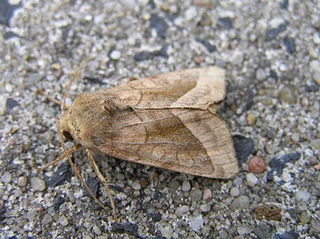
The red underwing is a moth of the family Erebidae. The species was first described by Carl Linnaeus in his 1767 12th edition of Systema Naturae.

Apatura iris, the purple emperor, is a Palearctic butterfly of the family Nymphalidae.

Apamea crenata, known as the clouded-bordered brindle, is a moth in the family Noctuidae. It is distributed throughout the Palearctic realm. In the North it crosses the Arctic Circle, in the Mediterranean it is found only in cool locations and mountains avoiding very hot areas. In the Alps, it rises to an altitude of about 2000 metres.

Apatura ilia, the lesser purple emperor, is a species of butterfly native to most of Europe and east across the Palearctic. It is named for its similarity to the purple emperor butterfly.

Deudorix epijarbas, the cornelian or hairy line blue, is a species of lycaenid or blue butterfly found in south and southeast Asia from India to Fiji, including the Philippines, and also the tropical coast of Queensland in Australia. The species was first described by Frederic Moore in 1857.

Morpho aega, the Aega morpho, is a Neotropical butterfly found in Paraguay, Argentina and Brazil.

Hydraecia micacea, the rosy rustic, is a moth of the family Noctuoidea. It is found across the Palearctic realm from Ireland to Siberia. It reaches Japan and is introduced to eastern USA, Quebec and Ottawa.

Tiliacea citrago, the orange sallow, is a species of moth of the family Noctuidae. It is found in Europe as far east as the Caucasus Mountains and the Urals.

Pachetra is a monotypic moth genus of the family Noctuidae erected by Achille Guenée in 1841. Its only species, Pachetra sagittigera, the feathered ear, was first described by Johann Siegfried Hufnagel in 1766. It is found in central and southern Europe, east to the Ural, north to southern England, Sweden and Finland. Southwards it is found from Anatolia, central Asia and the Altai up to Mongolia. It is also present in North Africa.

Grammodes stolida, the geometrician, is a moth of the family Erebidae. The species was first described by Johan Christian Fabricius in 1775. It is found in Africa, southern Europe, most of Asia and Australia. It migrates to central and northern Europe as far north as England, Denmark and Finland.

Papilio ambrax, the Ambrax butterfly, is a butterfly of the family Papilionidae. It is found in Queensland, Australia, as well as the Aru Islands, Papua (Indonesia), and Papua New Guinea.

Papilio ornythion, the ornythion swallowtail, is a swallowtail butterfly of the subfamily Papilioninae. It is found in Mexico and Guatemala. It is occasionally recorded from central and southern Texas and New Mexico and rarely from southern Arizona and Kansas.

Papilio torquatus, the torquatus swallowtail, is a swallowtail butterfly in the subfamily Papilioninae. It is found from northern Argentina to Mexico.

Cyrestis lutea, the orange straight-line map-wing or little map-wing, is a butterfly of the family Nymphalidae. It is found in Indonesia.

Papilio iswara, the great Helen, is a species of large swallowtail butterfly found in parts of Southeast Asia.

Chersonesia is an Indomalayan butterfly genus in the family Nymphalidae. The common name is maplet.

Eurytides agesilaus, the short-lined kite swallowtail, is a medium-sized species of butterfly in the family Papilionidae.

Graphium bathycles, the veined jay, is a butterfly in the family Papilionidae, that is found in the Indomalayan realm.

Cyrestis acilia is a butterfly in the family Nymphalidae. It is found in Sulawesi the Australasian realm including Sulawesi mainland, Buton island, Kabaena island and Wowoni island. See subspecies.
Chersonesia niceville is an Indomalayan butterfly in the family Nymphalidae (Cyrestinae). It is found in Sumatra and Peninsular Malaysia.



















